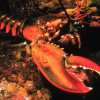Testing Tidal Stream Generating Technologies
Interview with
In the emerging field of marine renewables, tidal stream technologies need to be rigorously tested before being deployed in the open seas. The industry has settled on a design that resembles structures found on onshore wind farms; testing their efficiency in the lab is Luke Myers. He's an associate professor of marine energy and micro-renewables at the University of Southampton, Harry Lewis paid him a visit...
Luke - So my stock answer when I'm in the pub and people say, what do you do? I say, underwater wind turbines. And that's because the tidal industry has quite quickly narrowed down onto a marinized version of a wind turbine. Previously, we've had a few sort of more novel designs. We've had vertical axis, and historically we've had wind turbines like that. And we've had some that have been like one of those lawn mowers that spin round, you know, with their blades out the front. We've also got them in ducts. So, basically channeling the flow through the blades. And then finally, we've had some sort of flapping hydrofoils that look a little bit like a dolphins tail.
Harry - So lots of prototypes. And why is it that the industry seems to be settling on an underwater wind turbine?
Luke - I think because that way there's a lot of technology transfer between wind and tidal in terms of things like the power train and the electronics and all that sort of the back end of the system, fundamentally it's mechanically identical.
Harry - And so go on then what have we got in front of us?
Luke - So we have something that's broadly similar to a lot of the devices you might see on the internet. Now it's a three bladed upwind or upstream tidal turbine. The diameters are reconfigurable so we can put different size blades on them. It depends on the amount of force that the model can take and also how much electricity we generate as well.
Harry - You've pulled out a different blade and what's most startling about it is the fact that it's bright gold. So it looks fantastic. Also the wing tip is slightly different. What's this got to do with the prototype that it is in front of us?
Luke - Okay. So the reason it's gold is that this is aluminium is anodized to stop it corroding.
Harry - So this is on purpose. It's not just a style choice.
Luke - No. With the blades, we have to keep a very precise shape on them. So if the shape changes through corrosion or any sort of biofouling, it ruins the performance. The uplift at the end of the blade is what you see on most commercial passenger aircraft, which is they're called winglets. The idea is that they stop turbulent flow, falling off the edge of the wing and what that does, it creates drag for an aircraft. So it reduces the performance. It does a similar thing for a tidal or a wind turbine as well. The cost of adding a winglet to a blade is really quite cheap when you're making your blades out of glass or carbon fiber. So, it just needs a different mold. And then the material cost is relatively small. And we found an increase in the rotor power, almost 10%, which is huge.
Harry - When you found this out, you sent this to one of the commercial companies that you've been working with as a research facility. What's that relationship like between industry and research at university or other educational facilities?
Luke - We are trying to liaise and work with an industry that is highly competitive because it's at that nascent sort of development stage. So sometimes for us, it's quite difficult to work with multiple companies. So either on the same project or sequentially, but it''s completely understandable that if they have an industry advantage they want to keep that. So when we discovered the uplift and performance from designing the winglets, I realised we needed to get the results out fairly quickly. So, I actually contacted one of the large manufacturers via web form and said, I've got this amazing research and I'm happy to give it to you straight away. And so three people came back on the email in touch, sounding very excited. Then it turned out that they had no idea that we did any of this work, no idea that we had all the facilities and the capabilities that we do. So it kind of goes to illustrate just how sort of insulated and busy, you know, these sort of companies are. They don't have the resources to check up on what we're doing. So unless we're working together directly on a research project, they may never know of what we've done.
Harry - And they might not know, like you said about all the facilities that you have here. And hopefully if there's someone downstairs, we might get to have a look at the I've forgotten what the room's actually called again.
Luke - At Southampton we have the UK's largest towing tank, which is effectively a very large swimming pool with a wave maker at one end and a motorized carriage that zooms up and down. So we'll go and see that.
Harry - It looks a little bit like something out of Q's testing lab at the bottom of MI5 or MI6.
Luke - And obviously you get the awesome echo as well.
Harry - So when it comes to taking that prototype of yours that you've got and placing it in the water, what's the process here? How does this facility help you?
Luke - It's a body of still water. It's 138m long. It's 6m wide and it's 3.5m deep. And what we can do here is we can tow things like model ships and vessels and tidal turbines through this body of water. There's also a 0.3 mm difference from one end to the other to account for the curvature of the earth, because of the length of the tank. We have a 6.5m wide carriage at one end, and that is towed via a overhead cable up and down this tank backwards and forwards up to about 12mps, which is frighteningly fast if you're on board.
Harry - Oh, so your turbines, in this instance, they're not sitting on the bottom of the pool. They're actually being dragged through to give the impression of a current?
Luke - In a similar way that a wind tunnel works. So you could have a formula one car that's going around a circuit and you could measure the forces on it. Or you could make it still in a wind tunnel and move the air past it. So that's often what we do in engineering. The advantage of this one is that we're not moving the water, which takes a lot of energy.
Harry - When it comes down to the prototypes that you produce and what's on the market. How efficient are these wind like turbines that go underwater?
Luke - So our relative efficiencies for our models alone are comparable to full scale wind turbines already. So we get a, what's called a coefficient performance. For our small models is around about 0.42 and the largest wind turbines around about 0.5 something. So, for that coefficient performance, that efficiency gets better as you get bigger.
Harry - And what does that mean?
Luke - That's a proportion of the available energy that you can turn into electricity. So for example, if you take a coal fired power station, it has a similar coefficient of around about 35%. So for every three units of coal, you burn, one unit goes into electricity and two get wasted as heat and other losses.
Harry - So do you think that technology's going get better and be able to take on even more of that energy that those currents are producing?
Luke - Yeah. So we have some currents which are frighteningly fast, especially up around the western coast and up to the north of Scotland. They're around about 5mps? So that's 10 knots. For reference, one cubic meter of water weighs the same as a family car. So for every square meter of area, that's five family cars hitting you every second. So its epic amounts of engineering term, epic amounts of kinetic energy.
Harry - And compared to wind that that's not under nearly as much stress, because the stuff must be moving quicker, but at the same time, far less dense.
Luke - Yeah. So tidal turbines, the thrust force per unit area. So the amount of stuff that's hitting you per unit area is orders of magnitude higher. It's much greater. So tidal turbines will be much more compact and much smaller. We'll never see 80m diameter tidal turbines, because the forces are so great underwater. So they'll be far more far more compact and smaller and sort of hidden under the water
Harry - Again in comparison to wind turbines, how much energy are we able to take from a single tidal turbine compared to a wind turbine?
Luke - I think ultimately it depends how big tidal turbines get. At present because of the high forces and the efforts you need to make to resist those forces, effectively so your blades don't snap off. Current thinking is that around about 20m in diameter is going to be the maximum for a tidal turbine. Now the power output depends on the speed of the flow, but really roughly I think individual turbines have between one and two megawatts.
- Previous Gaming News for May 2022
- Next Generating electricity from water










Comments
Add a comment